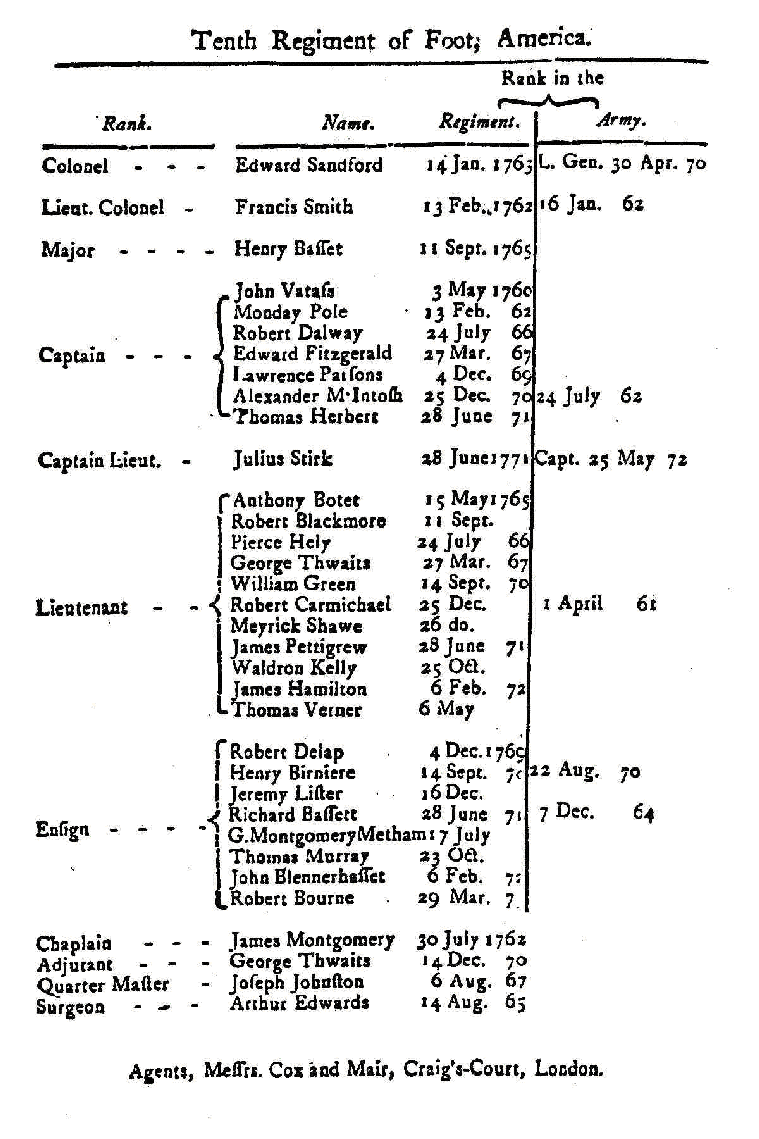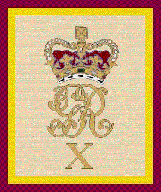H.M . Tenth Regiment of Foot Music Company | home
History of the Tenth Regiment of Foot | Calendar | Band of Music | FAQ's about Fife and Drum | The Role of the Musicians | Overview of this month's events | Photo Index | Related Links | Join His Majesty's Tenth Regiment of Foot | A Day in the Life of a reenactor
History of the Tenth Regiment of Foot

Capt. Richard Amsterdam and Sergeant Major William Desmond holding the King's Colours and the 2nd colours, or better known as the regimental colours. (King's on left, 2nd on right)
(photo courtesy of Don Gelinas)
In 1685, James II commissioned Major General John Granville to create 11 new regiments of foot. The Tenth Regiment, then called the Earl of Bath's regiment, was formed to partake in the Monmouth Rebellion. The regiment fought in the war of the League of Ausburg and in the Spanish Succession. However it did not partake in the Seven Years War more commonly referred to in America as the French and Indian War. They were stationed on Gibraltar for the majority of the time. It became the Tenth regiment of foot in 1751. Sailing from Cork Island. The regiment then served in America at the skirmishes of Lexington and Concord, Breed's Hill, Long Island, The Invasion of Manhattan, and the battles of Germantown and Monmouth. It's last duty was to defend Newport, Rhode Island and Quaker Hill before departing in 1778. The regiment returned to England in December of 1778 for the first time in forty years. It then became known as the Linconshire Poachers due to the County of England they are from.
This is a short summary based on the History of the Old Corp from the Home page of the Tenth Regiment of Foot

Back in the glory days of the regiment, this is only two companies. The third was the Grenadiers. However not visible in this picture.
**new**
Break Down in officer of H.M. 10th Regiment of Foot

This is an image of the units officer roster. Some familiar names are Lieut.-Colonel Francias Smith (CO of the Lexington Concord skirmishes). **New**
The Uniforms of the Tenth Regiment of Foot
The regiment's uniform consists of a redcoat faced in yellow, facings are the colors of the lapel, cuffs, and collar, the opposite would be for the musicians. Yellow coats with red facings. The cuffs, collar, lapel, and pocket had trim on them, the tenth's regiment's trim is white with a thin blue line running through it. The musicians had lace additionally on the arms, and back.
There were four different kinds of hats, the first being the most common were for that of Battalion, or normal infantry. It was a cocked hat consisting of a peak in the center, and two prominent corners, it was trimmed in white, and had a black cockade on it. The Grenadiers had a 12-inch tall hat made from bearskin with a front-plate made of white metal then having the background of the plate filled in with black enamel or Indian Ink making the embellished words and figures stand out from the plate. On the back there was a piece of scarlet cloth with the number of the regiment sewn on to it, it also had a medal grenade with the number of the regiment on it. The light infantry had black leather skull caps with a front plate with the initials G R on the front with the number of the regiment underneath it. On the top of the skull cap was a medallion with the number of the regiment on it. On the top winding down about half the height of the skull cap was a silver chain , it wrapped around three to four times, some believe this to be solely decoration but other believe it to have been meant to stop saber slashes to the head. The musicians caps were also made of black bear skin the only differences were that it was two inches shorter than the grenadier cap and the front plate had pictures of trophies and colors on it. The hair for normal camp life and battle was usually natural hair color, the hair color for parades and ceremonies was white tied in a club in the back and having one roll on each side of the head. The grenadiers and light infantry braided theirs instead of the usual club.
The small clothes, which consist of a vest, breeches, socks, and a shirt were white. The breeches had brass knee buckles on them. The socks were to be held up by black garters. Around their necks their wore a black neck stock made of rigid leather and horse hair which limited movement of the head. For footwear they wore black shoes with no right or left to them. They would have to change the foot of the shoe weekly so that it would not take on a certain form to a foot. Covering the shoes were black half-gaiters for battalion and light companies, and full gaiters for grenadiers except when in parade everyone wore full length gaiters.
For accouterments it is as follows. Cartridge box straps were to be white for the Grenadiers and Battalion, but for light infantry they were black leather. The cartridge box was black with the regimental badge on it. The bayonet belt followed the same rules as the cartridge box strap. The sheath for the bayonet was black. The haversack was white with the number "X" written in black. The cartridge box had a brass badge with the number" X" written on it, this medallion was known as a cypher. Officers who carried swords had a strap color the same as their respective companies . Officers also wore gorget made of brass, gold, or gilt.
The standard weapon of an infantry men was a second model Brown Bess. Notoriously inaccurate with a range of under fifty yards. It must be able to fit bayonet. A few selected marksmen were given the privilege of a Ferguson Rifle. It was the earliest known breechloaders. It was also very short (82cms) so it was fixed with a bayonet more than 62 inches long. Finally officers sometimes carried a fusel. The fusel they carried was similar to the Brown Bess in appearance but more than a foot and a half shorter.
Musicians carried usually one of two different instruments. The drum which was made of wood and painted with the King's crest and the number of the regiment painted on it, or a fife. A woodwind instruments similar to the look of a flute, but with a sound closer to piccolo.

H.M. Tenth Regiment of Foot and 74th Regt. Of Foot come to Charge Your Bayonets at a demonstration for the War Veteran's Hospital in Bennington, Vt. We then went into the audience and talked to the veterans, it was a truly emotional experience.
